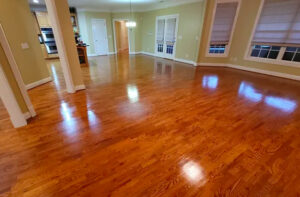
How Hardwood Floor Refinishing Works
Hardwood floors can be refinished to bring new life to an existing room. Hardwood Floor Refinishing Bergen County NJ job requires certain preparation and can be very time-consuming. It is important to determine whether a full refinish or a screen and recoat is needed. A recoat involves abrading the floor with a buffer and applying a new protective covering.
The first step in refinishing hardwood floors is sanding. To make the job go faster, hire a professional with a big sanding machine with an attachable vacuum to suck up the dust as it goes. The sander will also have an edger and a hand scraper to get into corners and around baseboards. The professional may even offer a dustless sanding option, which is a good idea if you have allergies or asthma.
Start with a coarse sandpaper, such as 36-grit, to remove any old finish and significant imperfections. Then, move to a medium-grit sandpaper, such as 50 or 60 grit. After that, use a finer sandpaper, such as 120 screen, to smooth out the floor. Vacuum or sweep up the fine dust, then vacuum again before starting to prepare the surface for staining.
When sanding, it is important to follow the grain of the wood, as going against it can cause serious damage to the flooring. It is also important to keep the sanding machine moving at all times to prevent overheating, as this can cause the wood to deteriorate more quickly. Finally, if your floors have a very hard time taking a new coat of polyurethane, you can try spot sanding with 100-grit and then re-coating with an oil-based or water-based polyurethane that matches the sheen of your existing finish.
Another alternative to a full sanding is screening and recoating, which involves abrading the floor with a power buffer instead of removing all the existing finish. This can be a good option for older floors that aren’t ready for a full sanding, but it isn’t a suitable substitute for newer engineered wood floors. These floors are typically made of a thin layer of real hardwood bonded to a layer of cheaper material, such as plywood. If you sand an engineered wood floor too far, you risk ruining the hardwood veneer and exposing the plywood underneath, which is an irreparable mistake.
Before sanding, it’s best to completely clear the room of furniture, wall hangings and window treatments. It’s also a good idea to empty the closets if they are located in the room being sanded. The sanding process will create a lot of dust, so you’ll need to wear a mask and protective eyewear.
Staining
Once the sanding has been done and the floors are completely dry (which can take two to four days, depending on the size of your room), it’s time to stain. Before the staining starts, however, you will need to vacuum once again and wipe down your floor with a microfiber or tack cloth dampened with mineral spirits. This will make sure there is no dust left behind that could interfere with the adhesion of the finish to your hardwood.
The next step is to choose a color for your floors. This is a really important decision so it’s a good idea to talk to your floor professionals about what you’re looking for. They may even be able to test some stains on your actual floor so you can see what they will look like before the project gets started.
There are a lot of options when it comes to stain colors. You can keep it neutral with a natural-looking finish or add some warmth to your floors with brown tones. Some people even choose to go for a bright or dark color to create a dramatic effect on their flooring.
While the color of your stain is a big decision, it’s also worth considering how durable the stain will be. Certain stain colors are more prone to show scratches and scuffs than others, so it’s a good idea to consider how much foot traffic you will be getting in your home and what your lifestyle is like before choosing a color.
When it comes to stains, the best thing is to always do a small test patch first to make sure you’re happy with the color and texture. Also, don’t be afraid to ask your floor professional for some larger sample samples of the stains they have on hand so you can see what they will look like on your specific floors.
If you are refinishing engineered wood floors, it’s important to know that this type of material is not able to be sanded as deeply as solid hardwood floors. It’s not uncommon to accidentally sand through the veneer to expose plywood, which is an irreparable mistake and will likely require you to replace your entire floor.
Polyurethane
A polyurethane coating is a liquid plastic that dries to form a smooth, glossy finish. It is used on floors to provide durability, resistance to chemicals, water and abrasion, and an attractive appearance. Polyurethanes are manufactured by reacting a polyol resin with a diisocyanate hardener or curing agent. The resulting reaction product is then shaped into a variety of forms, including flexible foams and rigid foams, as well as speciality adhesives, sealants, chemical-resistant coatings, and elastomers.
In some cases, hardwood floor refinishing may be necessary to fix significant damage to the flooring. Major scratches that cannot be removed by regular cleaning, deep gouges, and water damage are signs that the time has come to refinish the floors. A professional refinisher will be able to fill in these damaged areas and blend them into the surrounding floors for a beautiful finished look.
Refinishing can also help prevent future problems with the hardwood. For example, water damage can wreak havoc with the structural integrity of the wood if not addressed promptly. Leaving water damage untreated can lead to warping and discoloration of the hardwood, as well as damage to adjacent boards. Refinishing can prevent this damage by sealing the existing hardwood and protecting it from further moisture damage.
When considering whether or not to refinish your hardwood floors, it is important to consider the condition of your floors as well as your overall remodeling and design goals. Refinishing will significantly increase the value of your home, as well as improve its durability and beauty. If you are ready to refinish your hardwood, contact a top pro near you for free, no-commitment project estimates.
Before refinishing, you will want to make sure that your floors are as clean as possible. It is recommended that you vacuum and use a tack cloth to remove any dust or other particles that could mar the final finish. It is also important to make sure that any furniture or other items are moved out of the room before beginning the sanding process.
Depending on the state of your floors, you may be able to skip sanding and staining and opt for resurfacing instead. Resurfacing involves adding a thin layer of material over the existing surface of your hardwood floors, which is ideal for homes that are not quite ready to commit to refinishing. This method is also a great option for those with existing floors that are not in perfect condition, but have no major scratches or other damage.
Finishing
After sanding, staining and refinishing the hardwood floor, it’s time for the top coat. A quality finish is a vital part of keeping your floors looking their best and protected from damage. There are several different types of finishes that you can choose from. Barnum Floors offers a variety of options from water-borne urethanes to oil modified urethanes and hard wax oils. We’ll work with you to select the best type of finish for your flooring.
The coating process will take one to two days, and it is very important that you are off of the hardwood areas during this entire step. If you have pets, they will need to be away from the hardwood as well. You will be given a schedule for when you can return to the hardwood areas, based on the dry time of your chosen product.
Hardwood floor refinishing can be a long process, but it’s worth the effort to maintain the beauty of your home or business. It will add value to your property and will keep your guests impressed with the cleanliness of your space.
There are several indicators that it’s time to refinish your hardwood floors. Heavy foot traffic is a good indicator, as are scratches and dullness. Older floors may need refinishing more frequently, depending on their age and the original finish type.
Engineered wood floors may need refinishing more often than solid wood floors, due to their thinner wear layers. It’s also a good idea to check the thickness of the veneer when the floors were installed, as cheaper options might only be able to withstand one refinishing, while higher-quality hardwood floors can usually handle two or more rounds.
If you’re unsure whether or not your hardwood floors need to be refinished, contact us for a free estimate. Our Bona Certified Craftsmen are trained and supported to utilize the full line of Bona professional products from dustless sanding to finishing. We can get you back to beautiful, refinished hardwood flooring with minimum disruption to your home or business.
